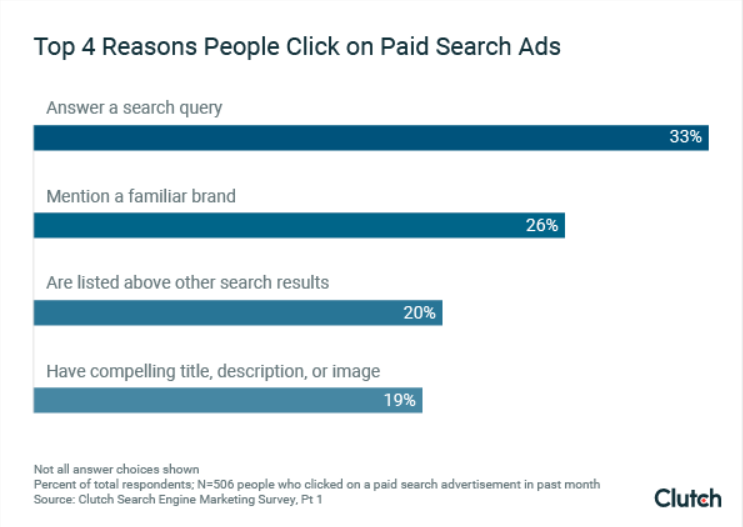Ever since the moment of its conception, marketing and advertising have been constantly researching the way users relate to ads.

The research is plenty and varies, but none of it has ever gone deep into digital marketing.
Now, thanks to the advertising firm, Clutch, we have a better understanding about what goes on in the user’s mind before clicking an ad.
What do we want from an ad?
According to the research, 33% of the population assures that the first thing they look for is an answer to their questions.
In other words, we all know that the main reason anyone goes into Google is to solve a doubt. If the ad can resolve clearly and to the point, one third of users will click on your page.
Meanwhile, 26% reports they click when a familiar brand is mentioned. This speaks a lot about brand fidelity and user trust.

And this is not only abour big international Wall Street brands like Coca-cola or Apple, but also for small brands such as Mobo and Logitech, they are well-known amongst users, just not in a worldwide scale like the formers.
Finally, we can’t just ignore the last to reasons, which include: be well positioned in the first page of results (20%) and having good content, be it title, image or description (19%).
This means that generic posts will no longer be functional.
We must use every tool we have at our disposal like Machine Learning and Big Data Analysis to personalize our ads in a way that are clear and valuable.

People can recognize paid ads.
One of the big topics of last year was labeling paid ads properly, and the audience has been paying attention.
77% of users report recognizing easily Internet ads.
They also report that it’s not enough to be in the first positions of the page because users are still looking at organic posts to compare content.

Google is the king of clicks
Knowing that users go into search engines to solve general questions about a wide variety of topics, then it’s clear that Google is king here.
Users say so themselves, 66% report giving more clicks to Google than Amazon or YouTube, even though YouTube has actual tutorials that answer many questions in a more interactive way.

YouTube and Amazon have strong reasons to be second and third place, though. Afterall, both sites can help fixing problems in their own unique way.
If a user needs computer parts, a cocktail dress or any othe emergency article, Amazon can solve that in minutes.
Meanwhile, YouTube, as we explained before, has many tutorials. From tying your tie to fixing an internal combustion motor.

Text works better than anything else
So, which ads work better? That’s the proverbial question.
If we look at the data we find that 49% of users claim it’s highly probable they click on a text ad, compared to the 39% that actually clicks on sopping listings.
It’s important to say, thought, that on search videos have less clicks than any other kind of ad, so it might be better to keep those videos for other platform.
What’s the lesson here?
It’s no longer enough to try to find the best bid to position our ads, we also have to use the tools within our reach to creat an ad that is actually usefull and compeling for the user.
And this is where the Google Ads Extensions shine, paired with Data Analysis and Machine Learning, we can create ads carefully segmented with higher chances of conversion.

Now, it’s necessary to incorporate this with our ideas and knowledge. Knowing the main goals of your brand will help you understand queries one might want to solve.
Otherwise, you could end up having a higher bounce rate on your page.
This takes us to landing pages.
Sources:
www.smartinsights.com
www.blog.google.com
www.searchenginejournal.com

